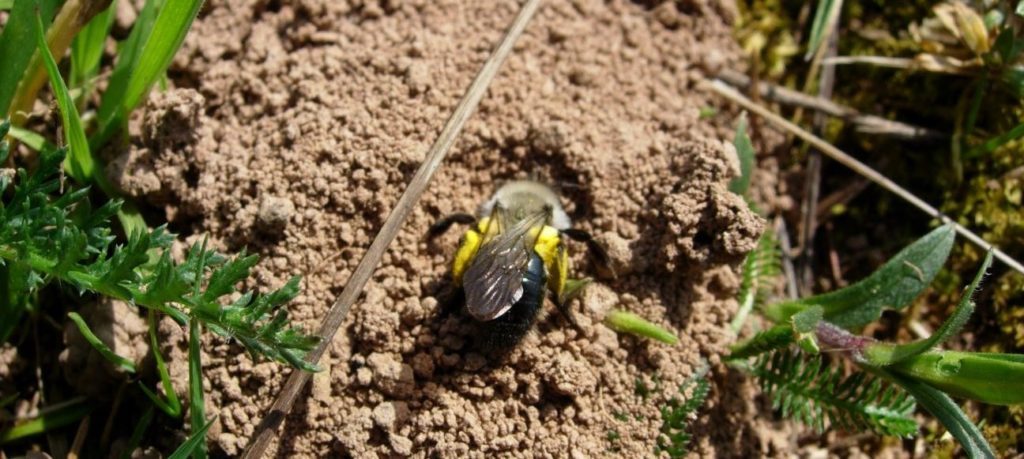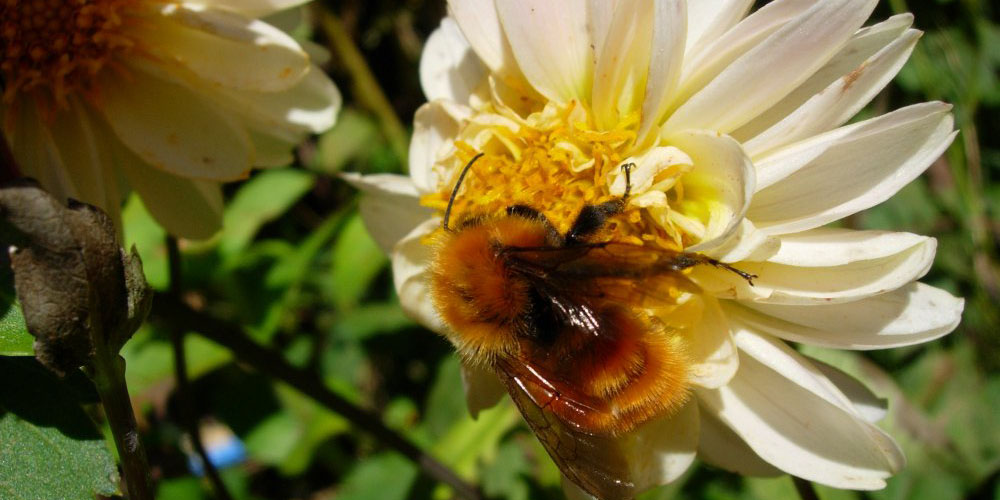Bees are a classical example for central place foraging. It may sound abstract but simply means that the activity of an animal displays around a “home base”. There is a central point to which they return. This applies quite well for bees, at least for the females (and I’m leaving out cuckoo bees, too…). The central place definitely is the nest. It’s around this point that the females move – at least as long as they provide it. This means that the resources they need – flowers and nesting materials – should be within a circle around this nest. This is important to consider if you want to conserve, restore or create bee habitat.
Central place foraging and flight range
In this context, knowing how far bees fly is important. There’s the maximum flight range, i.e. how far do they get if they have to. And there’s the distance they usually forage in. For instance, honey bees (Apis mellifera that is) are known to have a flight range of around 5 km. There are data they flew even 14 km. But these maximum flight ranges are an exception. Usually, honey bees will try to forage in an area of 1.5-2 km around the nest. Why? Well, because foraging costs energy. A bee needs to fly to the flowers and back. The longer the distance, the more energy that takes.
Then, she doesn’t forage only for herself. She needs pollen and nectar for the brood. Social bees also need some for the queen and the workers staying at home. Therefore, she can’t just consume everything she forages herself. That means that flowers at larger distances must be very rewarding. But most bees will try to get everything they need from shorter distances.
Not all bee species are the same, obviously. Smaller bees fly shorter distances than larger bees. All of them may encounter landscape barriers, like large water bodies, mountains etc., that limit their foraging range. For conservation considering this is crucial. Especially keeping the central place foraging principles in mind.
Central place foraging and habitat fragmentation
Those of you who read this blog for a while know that I always insist on “habitat, habitat, habitat”. Habitat fragmentation, e.g. by a large road or human settlings, sometimes separates suitable nesting places from pollen and nectar sources. In consequence, bee species with a short flight range won’t be able to use either of the resources.
A Swiss study dealt with this problem: they assessed the maximum flight ranges of three solitary bee species. In addition, they also studied the abundance of marked females in certain distances from the nest. They found that the maximum flight range was larger than previously thought. But – and this is the essential point – 50% of the marked females foraged in a distance of only a few hundred meters around the nest.
What bees need
In this study, the authors conclude that for maintaining populations of endangered bee species the vicinity of nesting and foraging habitat is crucial. I often hear “plant and they will come”, but this doesn’t consider the importance of the nesting places. Or nesting materials in some species. Unfortunately, you may plant the most beautiful flowers, but if there’s nothing suitable to nest in or to build the nest with they won’t come. So let’s break apart what bees need.
Let’s start with the flowers. Not all flowers are suitable for every bee species. There are generalists (“polylectic bees”) that fly on every flower as long as they are able to get to nectar and pollen. And there are specialists, the so-called oligolectic bees, which collect pollen for their brood only on certain plants. Both of them are central place foragers. For oligolectic bees, however, this principle makes them more vulnerable: the conditions they need are so specific that they occur much less frequently even under undisturbed conditions.

Nesting places and materials
Talking about nests: this isn’t trivial at all. Most people may think of bee nests as a honey bee hive or maybe as cavities like those in “bee hotels”. But this covers only a small portion of bees. Most bee species nest in the soil, not in hives or bee hotels. Each species needs special conditions. Some like compact sand in vertical ridges, others prefer short lawn. Some dig the nests themselves (like mining bees), others use mouse holes, like some bumblebees.
Other bee species nest in cavities aboveground. This may be something like a bee hotel. Naturally, these bees use the tunnels some beetle or wasp larvae do in the wood. Or they may also use larger cavities between stones or similar structures. Every bee species is different. This is why – I’m sorry to say it – you don’t save bees with bee hotels. They’re great to observe some species, to learn about them. Considering that we can save only what we know, this is an important first step. But nothing else.
Finally, some bee species also need nesting materials. Red mason bees, for instance, need mud to separate the brood cells and close the nest. Leafcutter bees line their nests with small pieces of leaves – hence their name. Wool carder bees make a bed of plant wool for their offspring. And so on. Every species is different. And also collecting nesting materials follows the principles of central place foraging.
Saving the bees?
“Saving the bees”, as you see, isn’t as trivial as some news and initiatives want to make you believe. I also wonder why these slogans always have to simplify so much… But this is a recurrent theme in this blog. “Saving the bees” may be a good call to action. Thus, we have to be careful not to do things for the activity’s sake. As with everything: you have to know what you’re doing. I don’t want to discourage people, it’s more about being conscious of what everyone can do. And the limitations.
A bee-friendly garden helps. It can offer both foraging and nesting habitat for some species. Depending on the distance to natural habitat, it may also be a corridor together with other gardens. In any case, it will be a great place to enjoy and observe bees and flowers. When you’re lucky, with time, the right plants and nesting habitat, you may also see some rare species. It may be clear by now, that this needs some work and dedication to create the right conditions.
Flowering strips and other measures in agricultural landscape help. Especially if they are thoughtfully designed for the regional conditions, crops and bee fauna. However, in these cases, the principals of central place foraging are often neglected. Bees need flowers, but without nesting habitat nearby a stable bee population will be difficult.
Know what you’re doing
Fortunately, we’re getting more and more aware of how important bees – and pollinators in general – are. Diversity is getting more attention and the consequences of losing it. Despite some really discouraging tendencies in some regions of the world, policymakers, farmers, veterinarians etc. are caring about pollination services and ecosystem health. Which brings together the different areas of my work.
A farmer once answered her son for me when he asked how difficult beekeeping was: “Everything is difficult if you don’t know how to do it.” I couldn’t agree more. It’s difficult to “save the bees” if you don’t know how to do it. This is why this month I’m doing a series on “the bees’ needs” on this blog. If you want to learn what you can do, how you can add a small piece to the large purpose of keeping bee diversity stay tuned.



